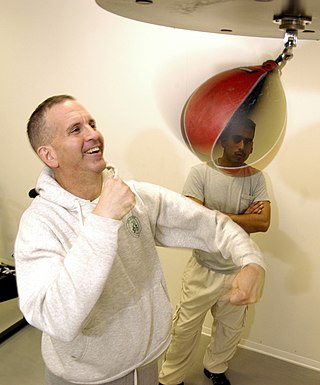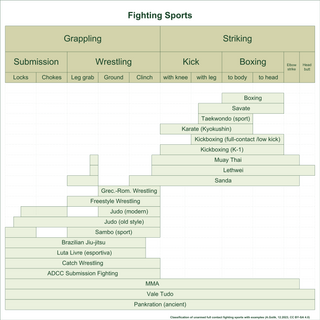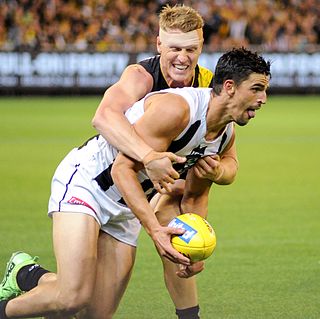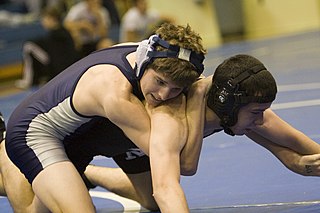This article needs additional citations for verification .(January 2021) |

Headgear is a padded helmet worn during sparring in the martial arts.
This article needs additional citations for verification .(January 2021) |

Headgear is a padded helmet worn during sparring in the martial arts.
Headgear is a padded helmet, worn on the head by contestants in Amateur and Olympic boxing. It effectively protects against cuts, scrapes, and swelling, but it does not protect very well against concussions. It will not protect the brain from the jarring that occurs when the head is struck. Also, most boxers aim for the chin on opponents, and the chin is usually not protected by headgear.
There are different types of boxing headgear available. Some headgear is open-faced. This is the style normally used in amateur boxing competitions. Unlike open-faced headgear, training headgear covers the cheek. "Face-saver" headgear features a pad across the face so that no direct contact is made to the face. As the amount of padding in headgear is increased, visibility is reduced.
In 1984, the International Boxing Association (AIBA) began to mandate the use of headguards in all amateur matches at the national, continental and international levels. [1]
In March 2013, the association announced that it would end the use of headgear in senior men's boxing (19–40 years old), while remaining mandatory for women and junior men. It cited recent studies finding that headgear actually increased the risk of concussions and head injuries, as they provided a false sense of security that encouraged boxers to take more risks (including harder punches at the head, and headbutts) than they otherwise might, and created vision obstructions that made their heads an easier target. The change was implemented in June 2013, and was adopted at the Olympics for the first time in 2016. [1] [2] [3]
The changes faced a mixed reaction, with critics believing that the headgear ban was to help make amateur boxing closer resemble professional boxing for marketing reasons, and would increase the risk of cuts. During the 2014 Commonwealth Games, the team of Daniel Lewis called for the decision to be reevaluated after he was ruled out after sustaining a cut during a match. In 2017, Boxing Canada reinstated the headgear mandate for senior men's boxing below the provincial level, in order to "ease our elite national boxers and prospects into competition without headgear." [4] [5] [6]
Wrestling headgear is designed to protect the ears from damage. It features either soft or hard plastic ear covers and straps around the chin and back of the head. It is commonly used in grappling sports such as amateur wrestling, submission wrestling and Brazilian jiu-jitsu.
Point fighting headgear, which is commonly required in sport karate tournaments is made of a molded and dipped foam. This type of headgear is most common in no contact and semi contact fighting. It is designed to protect against accidental impact, including the head hitting the floor after a slip or knockdown. This sort of headgear can be open face, full faced and sometimes even a full plastic face shield.

World Taekwondo requires red or blue head protectors. They can be provided with electronic sensors to register hits. [7]

Boxing is a combat sport and martial art. Taking place in a boxing ring, it involves two people – usually wearing protective equipment, such as protective gloves, hand wraps, and mouthguards – throwing punches at each other for a predetermined amount of time.

A knockout is a fight-ending, winning criterion in several full-contact combat sports, such as boxing, kickboxing, muay thai, mixed martial arts, karate, some forms of taekwondo and other sports involving striking, as well as fighting-based video games. A full knockout is considered any legal strike or combination thereof that renders an opponent unable to continue fighting.

Boxing training is the training method that boxers use in order to get more fit for their sport.

A combat sport, or fighting sport, is a contact sport that usually involves one-on-one combat. In many combat sports, a contestant wins by scoring more points than the opponent, submitting the opponent with a hold, disabling the opponent, or attacking the opponent in a specific or designated technique. Combat sports share a long history with the martial arts.

A contact sport is any sport where physical contact between competitors, or their environment, is an integral part of the game. For example, gridiron football. Contact may come about as the result of intentional or incidental actions by the players in the course of play. This is in contrast to noncontact sports where players often have no opportunity to make contact with each other and the laws of the game may expressly forbid contact. In contact sports some forms of contact are encouraged as a critical aspect of the game such as tackling, while others are incidental such as when shielding the ball or contesting an aerial challenge. As the types of contact between players is not equal between all sports they define the types of contact that is deemed acceptable and fall within the laws of the game, while outlawing other types of physical contact that might be considered expressly dangerous or risky such as a high tackle or spear tackle, or against the spirit of the game such as striking below the belt or other unsportsmanlike conduct. Where there is a limit as to how much contact is acceptable most sports have a mechanism to call a foul by the referee, umpire or similar official when an offence is deemed to have occurred.

Amateur boxing is the variant of boxing practiced in clubs and associations around the world, at the Olympic Games, Pan American Games and Commonwealth Games, as well as at the collegiate level.

Boxing has been contested at every Summer Olympic Games since its introduction to the program at the 1904 Summer Olympics, except for the 1912 Summer Olympics in Stockholm, because Swedish law banned the sport at the time. The 2008 Summer Olympics were the final games with boxing as a male only event. Since the 2012 Summer Olympics, women's boxing is part of the program.

Sportswear or activewear is athletic clothing, including footwear, worn for sports activity or physical exercise. Sport-specific clothing is worn for most sports and physical exercise, for practical, comfort or safety reasons.

The International Boxing Association (IBA), previously known as the Association Internationale de Boxe Amateur (AIBA), is a sports organization that sanctions amateur and professional boxing matches and awards world and subordinate championships. It is one of the oldest boxing federations in the world, coming into existence after the 1920 Summer Olympics. The IBA consists of five continental confederations, the African Boxing Confederation, American Boxing Confederation, Asian Boxing Confederation, European Boxing Confederation, and Oceania Boxing Confederation. As of 2021, the IBA included 198 national boxing federations. It organises the biennial IBA World Boxing Championships, and governed boxing at the Summer Olympics until 2020.

Wrestling headgear is protection that a person wears over the ears and chin during wrestling matches.
Professionals and amateurs alike wear protective headgear (helmets) to reduce the chance of injury while playing American and Canadian football. The football helmet has changed over time and many different materials have become available. The rules of the game have changed as well.

The scrum cap is a form of headgear used by rugby players to protect the ears in the scrum, which can otherwise suffer injuries leading to the condition commonly known as cauliflower ears. Although originally designed for forwards they are now worn by players of all positions, even those who do not play in the scrum.

Association football headgear is worn by association football players to protect the head from injury. The headgear is designed to absorb the impact of blows to the head by external physical forces in order to reduce the chance of a concussion, a noteworthy example in international football being Czech goalkeeper Petr Čech from Chelsea. These collisions can occur from head to head, head to ground, head to goal post, or head to body extremity contact. It is flexible, not a rigid helmet.

A lacrosse helmet is a helmet worn primarily in men's lacrosse, but also worn optionally by women's lacrosse players in Australia. Modern helmets consist of a hard plastic, non-adjustable shell with thick padding on the inside, a face mask made of metal bars, and a chinstrap used to secure the helmet to the head. Some players also attach a sun visor shielding the eyes, though these visors are not legal in most leagues.

The use of personal protective equipment (PPE) is inherent in the theory of universal precaution, which requires specialized clothing or equipment for the protection of individuals from hazard. The term is defined by the Occupational Safety and Health Administration (OSHA), which is responsible for PPE regulation, as the "equipment that protects employees from serious injury or illness resulting from contact with chemical, radiological, physical, electrical, mechanical, or other hazards." While there are common forms of PPEs such as gloves, eye shields, and respirators, the standard set in the OSHA definition indicates a wide coverage. This means that PPE involves a sizable range of equipment. There are several ways to classify them such as how gears could be physiological or environmental. The following list, however, sorts personal protective equipment according to function and body area.

In boxing, a weight class is a measurement weight range for boxers. The lower limit of a weight class is equal to the upper weight limit of the class below it. The top class, with no upper limit, is called heavyweight in professional boxing and super heavyweight in amateur boxing. A boxing match is usually scheduled for a fixed weight class, and each boxer's weight must not exceed the upper limit. Although professional boxers may fight above their weight class, an amateur boxer's weight must not fall below the lower limit. A nonstandard weight limit is called a catchweight.

The boxing tournaments at the 2016 Summer Olympics in Rio de Janeiro took place from 6 to 21 August 2016 at the Pavilion 6 of Riocentro. However, boxing at the games was overshadowed with controversy after there were doubts raised that results in certain bouts had been manipulated. These concerns were upheld in a report published in 2021.
A sports-related traumatic brain injury is a serious accident which may lead to significant morbidity or mortality. Traumatic brain injury (TBI) in sports are usually a result of physical contact with another person or stationary object, These sports may include boxing, gridiron football, field/ice hockey, lacrosse, martial arts, rugby, soccer, wrestling, auto racing, cycling, equestrian, rollerblading, skateboarding, skiing or snowboarding.
Boxing competitions at the 2015 Pan American Games in Toronto were held from July 18 to 25 at the General Motors Centre in Oshawa. Due to naming rights the arena was known as the latter for the duration of the games. A total of thirteen boxing events will be held: ten for men and three for women.
Daniel Lewis is an Australian professional boxer. As an amateur, he won a gold medal while representing Australia at the 2011 Commonwealth Youth Games.